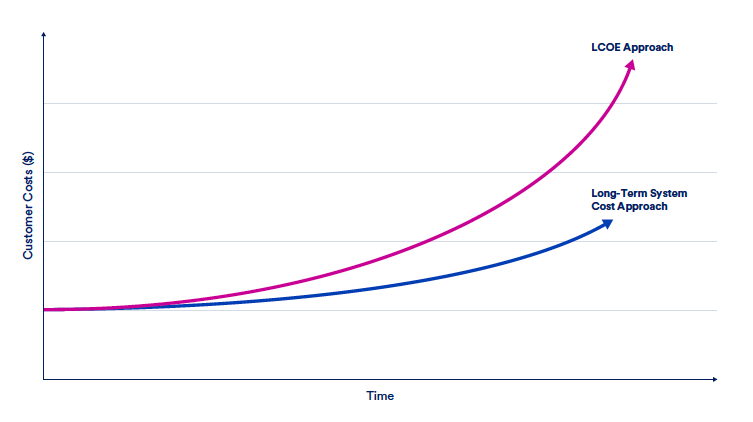
An introduction to the next clean energy frontier: Superhot rock geothermal and the pathways to national-scale adoption through experience-driven cost reductions
This blog is part of a series exploring and explaining the science behind next-generation geothermal, with a special focus on Superhot Rock Geothermal, through a curated tour of influential technical and academic papers. This edition highlights key features of the 2025 article by Ricks and Jenkins, Pathways to national-scale adoption of enhanced geothermal power through experience-driven cost reductions. The full blog series, in addition to their reference reports, can be found at the Superhot Rock Resource Library.
Next-generation geothermal systems hold substantial promise to provide clean, baseload electricity anywhere it is needed. Yet, as with many emerging technologies, today’s costs remain above market value, creating hurdles for investment and slowing progress. The combination of large upfront capital requirements and theperceived risks of new technology can deter investors, especially when questions remain about cost recovery and long-term returns. At the same time, next-generation geothermal offers major advantages: low operating costs, predictable performance, and insulation from volatile fuel markets or weather variability.
In the long run, the high upfront costs incurred by clean firm projects could prove modest when compared to the long-term value and stability they deliver to the grid. In their 2025 article, Pathways to national-scale adoption of enhanced geothermal power through experience-driven cost reductions, Ricks and Jenkins analyze and discuss the potential of enhanced geothermal systems to provide clean firm power across the U.S. and how the currently high upfront costs can be reduced.
Technology costs don’t reflect current or future technology value
Levelized cost of electricity (LCOE) is a widely used metric to compare the cost of individual energy projects by assessing the total cost of electricity generation per unit of expected output. While LCOE is useful for tracking how a technology’s costs change over time, it falls short as a comparison tool because it doesn’t account for the differing values each resource provides. Furthermore, comparing technology costs today doesn’t provide an indication of future value for emerging technologies that expect to see cost declines and for systems that will evolve over time. This is because LCOE doesn’t consider important system-level considerations, like:
- The electricity system’s needs and the value from the type of generation being built (e.g., variable renewables versus firm dispatchable resources)
- The full system costs necessary to deliver power to consumers (e.g., transmission and distribution infrastructure)
- Non-electricity factors and tradeoffs (e.g., land use, health effects, geopolitical tensions in the supply-chain, and local economic benefits)
Taken together, these limitations make LCOE too simplified a method to properly assess a project’s full value to the electric grid over time.
Comprehensive system studies often indicate that electric grids with a diverse set of transmission, clean firm power, renewables, storage, and demand-response technologies lead not only to a reliable and clean grid, but also lower overall costs for customers—even when some resources have high LCOEs (Figure 1). This contrasts sharply with analyses that compare LCOEs of clean firm resources, like next-generation geothermal, with other low-LCOE sources of electricity without accounting for their broader system value, such as maintaining reliability, offsetting long-term infrastructure needs and costs, and supporting efficient grid operation.

LCOE also does not indicate potential future cost and benefit implications of deploying a technology, especially for emerging technologies that expect to see cost declines with further development. System analyses that capture long-term impacts and consider all the system costs required to ensure a reliable and resilient gridsuggest that clean firm resources, such as next-generation geothermal, can lower total customer costs.
Enhanced geothermal systems could contribute up to a fifth of total U.S. electricity generation by 2050.
The high and uncertain upfront costs of EGS projects have often excluded them from macro-scale decarbonization studies, even though they are one of the few technologies capable of delivering clean firm power on a large scale. Furthermore, until the recent demonstration of EGS in the western U.S., the technology was not considered technically viable. Now, as one of only a few options capable of delivering clean firm power at scale, EGS warrants inclusion in these analyses. To better understand the potential of EGS to provide clean firm power across the U.S., Ricks and Jenkins utilized data from recent EGS projects to estimate the cost of constructing and operating 80,000 example commercial EGS projects in 2030 at a range of reservoir temperature, depth, and surface ambient air temperature. They then simulated the evolution of the U.S. electricity sector through 2050 across the contiguous U.S. Ricks and Jenkins initially considered resource temperatures up to 250 °C and assumed that higher temperature resources up to 350 °C are gradually unlocked following successful development in lower-temperature projects. With these assumptions, it should be noted that the successful deployment of even higher temperature geothermal systems, such as superhot rock geothermal, could provide more electricity to the market than is assumed in the modeling conducted here.
Ricks and Jenkins found that early deployment in the western U.S. can drive cost reductions in EGS through learning-by-doing (i.e., improvements over time with hands on practice), which can enable the development of deeper resources. We are already seeing evidence of substantial cost reductions in early projects in the western U.S., including the reductions in drilling cost at the Utah FORGE project. Ricks and Jenkins showed that these early projects in the western U.S. could lead to hundreds of gigawatts of EGS projects across the U.S., including in the eastern U.S.
Ricks and Jenkins modeled multiple pathways at a range of costs and policy scenarios (i.e., current policy and a net-zero policy). Their work showcases the importance of the current U.S. federal support for clean electricity, especially the technology-neutral tax credit, which was critical to the successful scale-up of EGS technology in their simulations. In their net-zero policy scenarios, EGS can meet nearly all the U.S. clean firm power requirements while supplying up to 1/5 of the total power generation in 2050. Additionally, their net-zero scenarios show that more than twice the EGS capacity is deployed in the eastern U.S. than in the western U.S., even though shallow heat resources are more prevalent in the western U.S. This is primarily due to the higher electricity demand in the eastern U.S. The increased deployment of EGS as a key source of clean firm power in their net-zero scenarios showcase the importance of policy as a key driver for development of EGS resources across the U.S. to help offset the current high upfront cost of EGS while costs are still being reduced through early-stage learning.
Ricks and Jenkins note that their scenarios that include high-cost assumptions under the current policies show only limited long-term expansion of EGS projects, but deployment tripled in size under policies that either expand the existing clean electricity investment tax credit (ITC), mandate deployment of clean firm resources, or create a technology-agnostic demand for 24/7 carbon-free electricity. It is notable that these policy scenarios are not EGS specific, but they help to advance EGS technology, due to its ability to provide clean firm electricity.
Although the work by Ricks and Jenkins details promising growth in the EGS sector, they also note that this growth is not guaranteed. The potential advancement in EGS projects across the contiguous U.S. could be slowed by higher costs, low learning rates, and/or a lack of supportive policies.
What’s next?
Although next-generation geothermal projects have high upfront costs, they provide a unique value to the electric grid as a source of clean firm electricity, which leads to the efficient use of transmission, small land requirements, and low emissions. Although these aspects are important to long-term planning of a cost-efficientelectric grid, the unique value add of clean firm sources of power, like geothermal, aren’t considered in the calculation of LCOE. Analyses that capture the full scope of costs and tradeoffs over a long-term horizon ensure a reliable and resilient grid that also achieves a lower overall cost, while benefiting early-stage sources of clean firm power, like next-generation geothermal.
Beyond recognizing the full value of geothermal to the electric grid, early-stage cost reductions through learning-by-doing, in addition to government support, are essential to advancing next-generation geothermal beyond the early deployment in the western U.S. that we are seeing today. Based on research conducted by Ricks and Jenkins, this could potentially allow for next-generation geothermal to supply up to 1/5 of the total U.S. power generation in 2050. Although this shows substantial promise, growth of the geothermal industry could be slowed by higher costs, low learning rates, and/or a lack of supportive policies.
Stay tuned for more from CATF as we continue to push forward bold ideas on how to scale superhot rock geothermal as an essential form of clean firm electricity.
This blog is part of a series exploring and explaining the science behind next-generation geothermal energy, with a special focus on superhot rock geothermal:
Through a curated tour of influential technical and academic papers, the series aims to provide a fresh perspective from a geoscientist entering the geothermal industry. The goal is to share my learning journey and encourage collaboration around these groundbreaking solutions, which are critical to achieving a clean energy future. Whether you’re new to geothermal or looking to deepen your knowledge, I hope this series offers valuable insights into this fast-evolving field.













